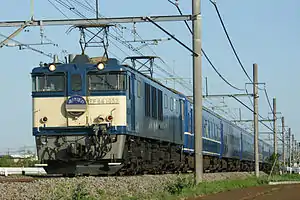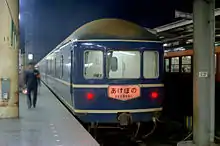Akebono (train)
The Akebono (あけぼの) was a seasonal limited express sleeper train service operated by East Japan Railway Company (JR East), which ran from Ueno Station in Tokyo to Aomori, via the Joetsu Line, Uetsu Main Line and Ou Main Line. The journey took approximately 12 hours.[2]
 An Akebono service hauled by an EF64-1000 locomotive in May 2010 | |
| Overview | |
|---|---|
| Service type | Limited express |
| Status | Discontinued |
| Locale | Honshu, Japan |
| First service | 15 July 1962 (Express) 1 July 1970 (Limited express) |
| Last service | 4 January 2015 |
| Current operator(s) | JR East |
| Former operator(s) | JNR |
| Route | |
| Start | Ueno |
| End | Aomori |
| Average journey time | 12 hours |
| Service frequency | 1 return working daily (seasonal) |
| Line(s) used | Joetsu Line, Uetsu Main Line, Ou Main Line |
| Technical | |
| Rolling stock | 24 series sleeper coaches |
| Track gauge | 1,067 mm (3 ft 6 in) |
| Electrification | 1,500 V DC / 20 kV AC (50 Hz) |
| Operating speed | 110 km/h (70 mph)[1] |
Service outline
During busy holiday seasons, one Akebono service operates in each direction daily between Ueno in Tokyo and Aomori, stopping at the following main stations. Prior to 15 March 2014, the train ran daily all year round. While JR East has not formally announced its discontinuation, no services have operated since January 2015.
Rolling stock
The train is formed of 24 series sleeping cars based at JR East's Aomori Depot, typically consisting of 13 cars including a KaNi24 generator car at the Aomori end.[1] The train is hauled by a JR East Nagaoka-based EF64-1000 DC electric locomotive between Ueno and Nagaoka, and by an EF81 between Nagaoka and Aomori.[4]
 An Akebono service hauled by a Class EF64-1000 locomotive in March 2013
An Akebono service hauled by a Class EF64-1000 locomotive in March 2013 An Akebono service hauled by a Class EF81 locomotive in June 2011
An Akebono service hauled by a Class EF81 locomotive in June 2011 An Akebono service heading toward Ueno in March 2010
An Akebono service heading toward Ueno in March 2010
Formation
Since the 15 March 2008 timetable revision, Akebono services are normally formed as shown below, with car 1 at the Ueno (Tokyo) end.[5]
| Car No. | 1 | 2 | 3 | 4 | 5 | 6 | 7 | 8 | |
|---|---|---|---|---|---|---|---|---|---|
| Type | OHaNeFu 25 | OHaNe 24 | OHaNe 25 | OHaNeFu 25 | OHaNe 24-550 | OHaNe 24-550 | SuRoNe 24-550 | OHaNeFu 25 | KaNi24 |
- Car 1 includes women-only couchettes and Goronto Seat couchettes without bedding.
- The KaNi 24 is a generator car.
Rolling stock timeline
The changes in rolling stock and locomotive haulage over the years are as shown below.[5]
Coaches

| Period | Coaches |
|---|---|
| 1 July 1970 - 1 October 1980 | 20 series |
| 1 October 1980 – Present | 24 series |
Locomotive haulage
| Period | Locomotive type |
|---|---|
| 1 July 1970 - 25 November 1975 | |
| 25 November 1975 - 1 September 1990 | |
| 1 September 1990 - 1 December 1993 | |
| 1 December 1993 - 22 March 1997 | |
| 22 March 1997 - 14 March 2009 | EF81 |
| 14 March 2009 – Present |
 An Akebono service hauled by Class EF71 and ED78 AC electric locomotives around 1987
An Akebono service hauled by Class EF71 and ED78 AC electric locomotives around 1987 An Akebono service hauled by a Class EF65-1000 DC electric locomotive in 1991
An Akebono service hauled by a Class EF65-1000 DC electric locomotive in 1991 A pair of Class DE10 diesel locomotives on an Akebono service in August 1992
A pair of Class DE10 diesel locomotives on an Akebono service in August 1992 An Akebono service hauled by a Class ED75-700 AC electric locomotive in March 2010
An Akebono service hauled by a Class ED75-700 AC electric locomotive in March 2010 An Akebono service hauled by a Class EF64-0 DC electric locomotive in 2009
An Akebono service hauled by a Class EF64-0 DC electric locomotive in 2009 Akebono service hauled by a Class EF81 locomotive in June 2007
Akebono service hauled by a Class EF81 locomotive in June 2007
Interior
 4-person couchette (lower berth)
4-person couchette (lower berth) 4-person couchette (upper berth)
4-person couchette (upper berth) Corridor
Corridor A "Solo" single-berth compartment
A "Solo" single-berth compartment
History
Sendai - Aomori express (1962 - 1968)
The Akebono was introduced on 15 July 1962, as an express service running between Sendai and Aomori via Akita.[6] The train operated using a three-car KiHa 58 series DMU formation, consisting of KiHa 58 + KiRo 28 + KiHa 58.[6] The down service departed from Sendai Station at 13:50, arriving at Akita at 18:35, and reaching Aomori at 21:56. The up working departed from Aomori at 06:25, departing from Akita at 09:50, arriving at Sendai at 14:30.[6]
From April 1963, between Akita and Aomori, the train ran coupled with the two-car Shirayuki (しらゆき) express service, which ran between Kanazawa and Aomori along the Sea of Japan coast.[6]
From the start of the 1 October 1968 timetable revision, the train was renamed Kitakami (きたかみ).[6]
Ueno - Aomori limited express (1970 - )
The name Akebono was revived from 1 July 1970 for a new overnight sleeping car service initially operating as a seasonal service between Ueno in Tokyo and Akita via Fukushima and the Uetsu Main Line using newly delivered 20 series sleeping cars.[6] From 1 October 1970, the train became a daily scheduled train, and was extended to run between Ueno and Aomori.[6] The down service departed from Ueno Station at 22:05, arriving at Akita at 07:20 the following morning, and reaching Aomori at 10:39. The up working departed from Aomori at 18:05, departing from Akita at 21:25, arriving at Ueno at 06:50 the following morning.[6]
From the start of the revised timetable in October 1973, a second daily return Akebono working was added, running between Ueno and Akita.[6] From 1 October 1980, the original 20 series sleeping cars were replaced by 24 series sleeping cars.[6]
From the start of the revised timetable in November 1982, a third daily return Akebono working was added.[6] However, with increasing competition from daytime train services and air services, services were cut back to two return workings daily between Ueno and Aomori from March 1988.[6]
From September 1990, with re-gauging work starting on the Ou Main Line between Fukushima and Shinjo in preparation for the new Yamagata Shinkansen, one return Akebono working was renamed Torikai (鳥海) and re-routed via the Joetsu Line and Uetsu Main Line. The remaining Akebono working was re-routed to run via the Rikuu East Line between Fukushima and Shinjo, requiring haulage by pairs of JNR Class DE10 diesel locomotives.[6]
From 22 March 1997, the train was again re-routed, this time running via the Joetsu Line from Ueno to Nagaoka, and then via the Uetsu Main Line to Akita and the Ou Main Line to Aomori.[5]
From the start of the revised timetable on 15 March 2014, regular Akebono services were discontinued, but services still operate during busy seasons.[5]
See also
References
- JR新幹線&特急列車ファイル [JR Shinkansen & Limited Express Train File]. Japan: Kōtsū Shimbun. 2008. p. 134. ISBN 978-4-330-00608-6.
- "JR Timetable" December 2008 issue
- "none". Tetsudō Daiya Jōhō Magazine (in Japanese). No. 298. Japan: Kōtsū Shimbun. February 2009. p. 128.
- あけぼの物語 [The Akebono story]. Japan Railfan Magazine (in Japanese). Vol. 54 no. 635. Japan: Koyusha Co., Ltd. March 2014. pp. 32–46.
- Teramoto, Mitsuteru (23 July 2001). 国鉄・JR列車名大辞典 [JNR & JR Train Name Encyclopedia]. Tokyo, Japan: Chuoshoin Publishing Co., Ltd. pp. 57–59. ISBN 4-88732-093-0.
External links
| Wikimedia Commons has media related to Akebono (train). |
- JR East Akebono train information (in Japanese)
.svg.png.webp)